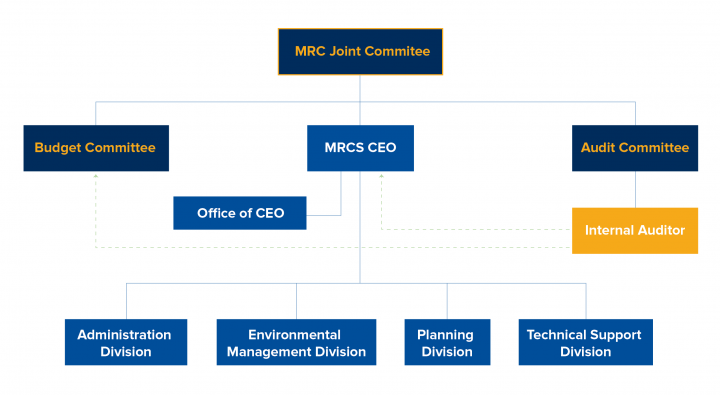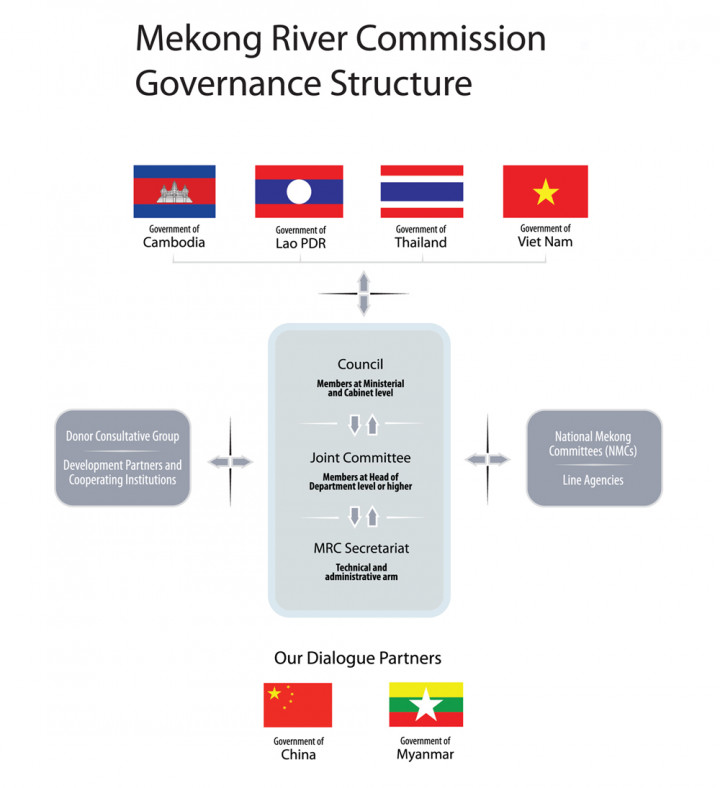Governance and Organisational Structure
The Mekong River Commission (MRC) consists of three permanent bodies: the MRC Council, the MRC Joint Committee, and the MRC Secretariat. The MRC Summit takes place every four years.
Summit of Heads of Government
The four-yearly MRC Summit of Heads of Government, first organised in 2010, is the highest political forum of the MRC whereby outcomes of cooperation are assessed, and directions set for the following four years. The fourth Summit in 2022 is an important milestone for the MRC to assess the direction of its work and support to the Member Countries.
Council of Ministers
As the highest decision-making body in the MRC, the Council approves the MRC Strategic Plan (SP) and makes decisions on all policy-related matters concerning its implementation, including organisational policies, basin-wide strategies and plans, strategic cooperation partnerships, and resolution of differences. The Council provides strategic guidance on priority setting, including by approving the multi-year work plans, including annual budgets, based on endorsement from the Joint Committee and the recommendation of the Budget Committee.
Joint Committee
In coordinating the implementation of the Council’s decisions, the Joint Committee (JC) steers the implementation of the MRC SP. This role includes technical priority setting and guidance on delivery of activities as well as reviewing and endorsing policy-related resolutions for submission to the Council for approval. The Joint Committee provides guidance on the preparation of the multi-year work plans, including the definition of activities and allocation of annual budgets.
The JC is assisted by task forces, working groups, committees, expert groups that provide technical input and advice on institutional, technical and policy related issues. The Budget Committee advises the JC on work plan and budgetary matters. The Audit Committee independently oversees the internal and financial control of the MRC and reports to the JC. As senior officials in their respective countries, Joint Committee members also have extensive networks which need to be mobilised to advance the MRC’s aims. The CEO works closely with Committee members in this regard.
MRC Secretariat
The MRC Secretariat is the operational arm of the MRC and performs technical, facilitating and administrative functions under the management of a Chief Executive Officer (CEO). It facilitates regional meetings of the Member Countries and provides technical advice on joint planning, coordination and cooperation. It also works closely with the four countries’ coordinating bodies, the National Mekong Committees (NMC) partners and stakeholders.
The MRC Secretariat undertakes many of the MRC SP activities in cooperation with national counterparts and others. Each of the Secretariat’s divisions and office will lead implementation of specific activities with the contribution of other divisions identified in delivery plans.
National Mekong Committees of Line/Implementing Agencies
In each Member Country, line or implementing agencies in water and related sectors, as well as those agencies relevant to Mekong cooperation (such as planning and investment and foreign affairs), are members of a NMC, supported by a Secretariat (NMCS) which performs cross-sectoral, cross-agency coordination, communication and reporting. The NMC Secretariats are attached to the ministry responsible for water resources management and/or environmental management. The chair of the NMCs are the level of Deputy Prime Minister or Minister, and the members are vice minister and Director General level from key line and implementing ministries.
Development Partners
While the Member Countries increase significantly their financial contribution to USD 25 million for the MRC SP 2021-2025 and therefore great ownership of the organisation, well in line with their commitment in the Roadmap for self-sustainability by 2030, cooperation and significant funding for the next five years would come from MRC's Development Partners (DP). DPs support the MRC and its Member Countries in their collective drive to balance development and protection of one of the world’s great rivers.
Structure and Governance of the MRC Secretariat
The MRC Secretariat consists of four divisions and one office: Administration Division (AD), Environmental Management Division (ED), Planning Division (PD), Technical Support Division (TD) and Office of the Chief Executive Officer (OCEO). The Organisation has more than 60 fixed term staff based at the MRC Secretariat Headquarters in Vientiane and the MRC’s Regional Flood and Drought Management Center in Phnom Penh. The MRC Secretariat is supported by various consultants at the national levels, and some of the best technical experts from the region and all over the world.
- Administration Division (AD): Provides administrative support to help management and staff enhance workplace effectiveness. AD manages financial transactions, human resource, and information systems and technology. It also supports the MRC Secretariat and the Member Countries in organising governance meetings, such as meetings of the Council, Joint Committee, Development Partners and Dialogue Partners.
- Environmental Management Division (ED): Plans, executes and manages the implementation of the MRC’s core river basin management functions such as environmental monitoring, analysis and assessment. ED leads the formulation and implementation of strategy for basin-wide environmental impact assessment and State of the Basin Report. It also manages the MRC’s assistance to the Member Countries for improved water quality and ecosystem in the Mekong River Basin.
- Planning Division (PD): Manages the formulation of the Basin Development Strategy, Sustainable Hydropower Development Strategy, and the updating of the Preliminary Design Guidance. PD supports the implementation of the MRC’s Procedures including the prior consultation process. It also manages the MRC’s assistance in the sectors of climate change, agriculture and irrigation, socio-economic and navigation, and the implementation of joint transboundary projects.
- Technical Support Division (TD): Manages database and information system, decision support system and modelling tools, flood and drought forecasting and early warning system, joint studies/research and assessment. TD supports the implementation of the MRC Procedures related to data sharing, maintenance of flows and water use monitoring, and assists the Member Countries in monitoring sediment flow, and water and climate. Additionally, TD manages the MRC Regional Flood and Drought Management Centre in Phnom Penh.
- Office of the Chief Executive Officer (OCEO): Manages the MRC’s work on strategic planning, international cooperation and partnership, communication and stakeholder engagement, monitoring and evaluation, fund-raising and organisational development. OCEO also supports the formulation and adoption of the Basin Development Strategy, Strategic Plan, and the implementation of the MRC’s Procedures.

MRC organisational chart
